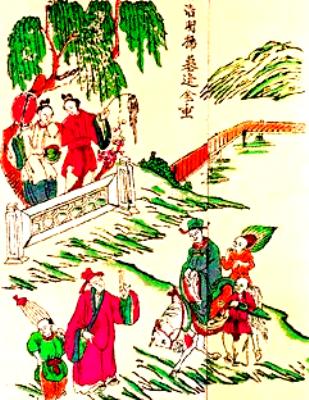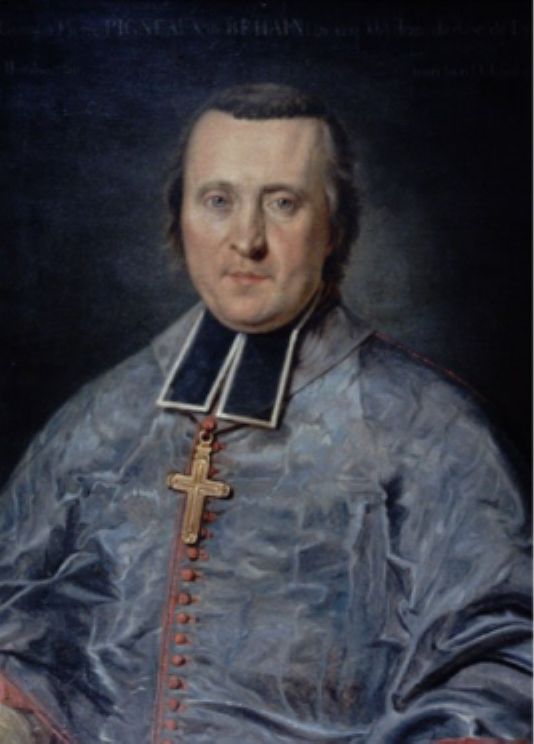|
The Tale Of Kiều
''The Tale of Kiều'' is an epic poem in Vietnamese written by Nguyễn Du (1765–1820), well known in Vietnamese literature. The original title in Vietnamese is ''Đoạn Trường Tân Thanh'' (, "A New Cry From a Broken Heart"), but it is better known as ''Truyện Kiều'' (, , lit. "Tale of Kiều"). In 3,254 verses, written in '' lục bát'' ("six–eight") meter, the poem recounts the life, trials and tribulations of Thúy Kiều, a beautiful and talented young woman, who has to sacrifice herself to save her family. To save her father and younger brother from prison, she sells herself into marriage with a middle-aged man, not knowing that he is a pimp, and is forced into prostitution. While modern interpretations vary, some post-colonial writers have interpreted it as a critical, allegorical reflection on the rise of the Nguyễn dynasty. The work is famous for its humane meaning and was translated into 20 languages, such as English, French, Japanese, and Korean. B ... [...More Info...] [...Related Items...] OR: [Wikipedia] [Google] [Baidu] |
Chữ Hán
( , ) are the Chinese characters that were used to write Literary Chinese in Vietnam, Literary Chinese (; ) and Sino-Vietnamese vocabulary in Vietnamese language, Vietnamese. They were officially used in Vietnam after the Red River Delta region was incorporated into the Han dynasty and continued to be used until the early 20th century. Terminology The main Vietnamese term used for Chinese characters is (). It is made of meaning 'character' and 'Han (referring to the Han dynasty)'. Other synonyms of includes ( , literally 'Confucianism, Confucian characters') and ( ) which was borrowed directly from Chinese. was first mentioned in Phạm Đình Hổ's essay ( ), where it initially described a calligraphic style of writing Chinese characters. Over time, however, the term evolved and broadened in scope, eventually coming to refer to the Chinese script in general. This meaning came from the viewpoint that the script belonged to followers of Confucianism. This is further s ... [...More Info...] [...Related Items...] OR: [Wikipedia] [Google] [Baidu] |
Art Name
An art name (pseudonym or pen name), also known by its native names ''hào'' (in Mandarin Chinese), ''gō'' (in Japanese), ' (in Korean), and ''tên hiệu'' (in Vietnamese), is a professional name used by artists, poets and writers in the Sinosphere. The word and the concept originated in China, where it was used as nicknames for the educated, then became popular in other East Asian countries (especially in Japan, Korea, Vietnam, and the former Kingdom of Ryukyu). In some cases, artists adopted different pseudonyms at different stages of their career, usually to mark significant changes in their life. Extreme practitioners of this tendency were Tang Yin of the Ming dynasty, who had more than ten ''hao'', Hokusai of Japan, who in the period 1798 to 1806 alone used no fewer than six, and Kim Jeong-hui of the Joseon Dynasty who had up to 503. History China In Chinese culture, ''Hao'' refers to honorific names made by oneself or given by others when one is in middle age. After one ... [...More Info...] [...Related Items...] OR: [Wikipedia] [Google] [Baidu] |
Beijing
Beijing, Chinese postal romanization, previously romanized as Peking, is the capital city of China. With more than 22 million residents, it is the world's List of national capitals by population, most populous national capital city as well as China's List of cities in China by population, second largest city by urban area after Shanghai. It is located in North China, Northern China, and is governed as a Direct-administered municipalities of China, municipality under the direct administration of the Government of the People's Republic of China, State Council with List of administrative divisions of Beijing, 16 urban, suburban, and rural districts.Figures based on 2006 statistics published in 2007 National Statistical Yearbook of China and available online at archive. Retrieved 21 April 2009. Beijing is mostly surrounded by Hebei Province and neighbors Tianjin to the southeast; together, the three divisions form the Jing-Jin-Ji, Jing-Jin-Ji cluster. Beijing is a global city and ... [...More Info...] [...Related Items...] OR: [Wikipedia] [Google] [Baidu] |
Ming Dynasty
The Ming dynasty, officially the Great Ming, was an Dynasties of China, imperial dynasty of China that ruled from 1368 to 1644, following the collapse of the Mongol Empire, Mongol-led Yuan dynasty. The Ming was the last imperial dynasty of China ruled by the Han people, the majority ethnic group in China. Although the primary capital of Beijing fell in 1644 to a rebellion led by Li Zicheng (who established the short-lived Shun dynasty), numerous rump state, rump regimes ruled by remnants of the House of Zhu, Ming imperial family, collectively called the Southern Ming, survived until 1662. The Ming dynasty's founder, the Hongwu Emperor (1368–1398), attempted to create a society of self-sufficient rural communities ordered in a rigid, immobile system that would guarantee and support a permanent class of soldiers for his dynasty: the empire's standing army exceeded one million troops and the naval history of China, navy's dockyards in Nanjing were the largest in the world. H ... [...More Info...] [...Related Items...] OR: [Wikipedia] [Google] [Baidu] |
Jiajing Emperor
The Jiajing Emperor (16September 150723January 1567), also known by his temple name as the Emperor Shizong of Ming, personal name Zhu Houcong, art name, art names Yaozhai, Leixuan, and Tianchi Diaosou, was the 12th List of emperors of the Ming dynasty, emperor of the Ming dynasty, reigning from 1521 to 1567. He succeeded his cousin, the Zhengde Emperor. The Jiajing Emperor was born as a cousin of the reigning Zhengde Emperor, so his accession to the throne was unexpected, but when the Zhengde Emperor died without an heir, the government, led by Senior Grand Secretary Yang Tinghe and Empress Zhang (Hongzhi), Empress Dowager Zhang, chose him as the new ruler. After his enthronement, a dispute arose between the emperor and his officials regarding the method of legalizing his accession. This conflict, known as the Great Rites Controversy, was a significant political issue at the beginning of his reign. After three years, the emperor emerged victorious, with his main opponents eithe ... [...More Info...] [...Related Items...] OR: [Wikipedia] [Google] [Baidu] |
Dap Deu Tai Tu Giai Nhon
DAP or Dap may refer to: Science * DAP (gene), human gene that encodes death-associated proteins, which mediate programmed cell death * Diamidophosphate, phosphorylating compound * Diaminopimelic acid, amino acid derivative of lysine * Diaminopyridine, drug for the treatment of rare muscular diseases * Diaminopyrimidine, a class of organic chemicals * Diammonium phosphate, chemical used as a fertilizer and flame retardant * Dog appeasing pheromone, synthetic analogue of a canine hormone * Dose area product, a measurement of radiation exposure Technology * DAP (software), a statistical analysis program * Debug Access Port, for ARM processors * Digital adoption platform, a type of automated software tool ** Digital Adoption Platform, software from WalkMe * Digital Archive Project, a collaboration for publishing non-mainstream TV programmes * Digital audio player, a class of electronic devices that play digital audio * Direct-Action Penetrator, the gunship version of the Sikor ... [...More Info...] [...Related Items...] OR: [Wikipedia] [Google] [Baidu] |
Emotional Labor
Emotional labor is the work of trying to feel the right feeling for a job, either by evoking or suppressing feelings. It requires the capacity to manage and produce a feeling to fulfill the emotional requirements of a job. More specifically, workers are expected to regulate their personas during interactions with customers, co-workers, clients, and managers. This includes analysis and decision-making in terms of the expression of emotion, whether actually felt or not, as well as its opposite: the suppression of emotions that are felt but not expressed. This is done so as to produce a certain feeling in the customer or client that will allow the company or organization to succeed. Roles that have been identified as requiring emotional labor include those involved in education, public administration, practice of law, law, childcare, health care, social work, hospitality industry, hospitality, media (communication), media, advocacy, flight attendant, aviation and espionage. As partic ... [...More Info...] [...Related Items...] OR: [Wikipedia] [Google] [Baidu] |
:Category:Chinese Courtesans
Chinese courtesans. Courtesans A courtesan is a prostitute with a courtly, wealthy, or upper-class clientele. Historically, the term referred to a courtier, a person who attended the court of a monarch or other powerful person. History In European feudal society, the co ... Courtesans by nationality ... [...More Info...] [...Related Items...] OR: [Wikipedia] [Google] [Baidu] |
Prostitution In Vietnam
Prostitution in Vietnam is illegal and considered a serious crime. Nonetheless, Vietnam's Ministry of Labour, Invalids and Social Affairs (Vietnam), Ministry of Labour, Invalids and Social Affairs (MOLISA) has estimated that there were 71,936 :prostitutes in the country in 2013. Other estimates puts the number at up to 200,000. Sex workers organizations report that law enforcement is abusive and corrupt. MOLISA reported that in 2011, 750 prostitutes and 300 pimps were arrested. 251 businesses had their business licenses revoked for involvement in the sex trade that year. History period It is unclear when prostitution and other forms of sex work first appeared in Vietnam. Possibly the earliest depiction or mention of female sex work in Vietnam is in ''The Tale of Kiều'' (), an epic poem written c. 1800 by celebrated Vietnamese writer Nguyễn Du. The poem's story centers on the life of , a young woman living in mid-16th century Đại Việt who sacrifices herself to sa ... [...More Info...] [...Related Items...] OR: [Wikipedia] [Google] [Baidu] |
Gia Long
Gia Long (Chữ Hán, Chữ hán: 嘉隆) ( (''Hanoi, North''), (''Ho Chi Minh City, South''); 8 February 1762 – 3 February 1820), born Nguyễn Phúc Ánh (阮福暎) or Nguyễn Ánh (阮暎), was the founding emperor of the Nguyễn dynasty, the last List of Vietnamese dynasties, dynasty of Vietnam, which would rule the unified territories that constitute modern-day Vietnam until 1945. A nephew of the last Nguyễn lords, Nguyễn lord who ruled over Đàng Trong, south Vietnam, Nguyễn Ánh was forced into hiding in 1777 as a 15-year-old when his family was slain in the Tây Sơn Tây Sơn wars, revolt. After several changes of fortune in which his loyalists regained and again lost Saigon, he befriended the French Catholic Church, Catholic Bishop Pierre Pigneau de Behaine. Pigneau championed Nguyễn Ánh's cause to regain the throne to the French government and managed to recruit volunteer; however, that soon fell through. From 1789, Nguyễn Ánh was once again in the ... [...More Info...] [...Related Items...] OR: [Wikipedia] [Google] [Baidu] |
Tây Sơn Dynasty
The Tây Sơn dynasty (; , (chữ Hán: 朝西山; Chữ Nôm: 茹西山), officially Đại Việt (Chữ Hán: 大越), was an imperial dynasty of Vietnam. It originated in a revolt led by three peasant brothers with the surname Nguyễn, rebelling against the Lê dynasty, Trịnh lords and Nguyễn lords (no relation). The Tây Sơn would later be succeeded by the Nguyễn dynasty.Kim, p. 359. The Tây Sơn dynasty ended the century-long war between the Trịnh and Nguyễn families, overthrew the Lê dynasty, and united the country for the first time in 200 years. They acknowledged Qing suzerainty and gained recognition from the Qianlong Emperor as the legitimate rulers of Vietnam. Under the most prominent of the Tây Sơn brothers Nguyễn Huệ Vietnam experienced several years of relative peace and prosperity. But Quang Trung died relatively young at the age of 40 and his successor Cảnh Thịnh, aged 9, was unable to prevent civil conflict among the Tây Sơn court ... [...More Info...] [...Related Items...] OR: [Wikipedia] [Google] [Baidu] |








